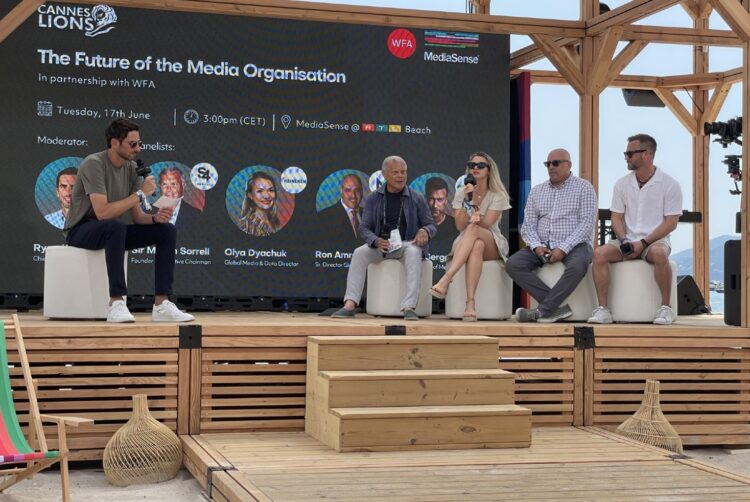What’s the future role of media? It’s complicated


The role and organisation of media in brands and their agencies is “fundamentally changing”, but the future standard for how brands reshape to better centre media and data is still up in the air.
That was one takeaway from a panel last week at RTL Beach in Cannes hosted by advisory MediaSense, which is set to publish a report on the topic in the coming months.
Previewing the findings, chief strategy officer Ryan Kangisser said that two-thirds (65%) of industry leaders believe the scope of media responsibility is expanding into greater disciplines, yet just one in three brands feel they have the right organisational structure for media.
“The essential challenge”, according to S4 Capital founder and CEO Sir Martin Sorrell, is: “How do you get, on the client side, people to think of themselves as one organisation? And on the agency side, how can you get people to behave in a unified way?”
The panel, comprising Sorrell, Kangisser, Mars senior director of global media Ron Amram, Heineken global media and data director Olya Dyachuk and Allwyn global head of media Ross Sergeant, failed to come to any consensus on how to adapt for the future.
Sorrell indicated that “the tail is now wagging the dog” at agencies, with holding group billings driven primarily by their media businesses.
“I’ve always thought the most relevant fear at WPP, for example, was not their revenues but their billings,” he remarked. “Media agencies, like it or not, are the dominant people in the organisation. The next WPP CEO could be a media person; we’ll see what they do.”
Sorrell added that tech and data is “becoming more important than creative” — something that has been reflected in the types of businesses that have become dominant along the Croisette in recent years.
“The creative, the tech and the data have to be brought together in the agency,” Sorrell stressed.
Amram noted: “A lot of what Cannes was about, historically, was great ideas, but not necessarily the data that creates those ideas. But you can’t, right now, in a great marketing organisation, separate media and production.
“That’s not something you had to say at a big CPG company 10 years ago. They weren’t saying it two years ago. Now, it’s a given.”
Integration needed… but who’s responsible?
But how to integrate siloed and disparate aspects of marketing? Sergeant admitted that Allwyn currently “doesn’t have the right media organisation”, acknowledging: “When we create siloes that match the agency siloes, we create problems.”
Dyachuk agreed, adding that “data is not the capability of one team” but, increasingly, of everyone within a brand’s wider marketing effort.
For Sorrell, the “Achilles heel” of clients and agencies is “politics with a small p”. Trying to fashion organisations in geographic structures, or segment them by capability or function, leads to severe business difficulties; yet, he argued, “the further you go up in an organisation, the more there is control of information”.
Leaders, Sorrell suggested, tend to prefer siloes whereas lower down in organisations people are keen for integration.
Meanwhile, creative commonly remains segmented despite the fact that, as Dyachuk lamented, brands often “create separate work for different touchpoints” without a sufficiently consistent overarching brand communications strategy.
Sorrell noted: “Just to be blunt: you walk down the Croisette, WPP has a beach and across the road there’s Ogilvy with a shop. Why? Why is that? They’re not acting as one.”
According to Kangisser, MediaSense has found that the “role of the integrator” is thus growing, but it’s unclear where such a role should sit within an organisation.
Amram argued that integration is a “shared responsibility”, but Sorrell disagreed, suggesting that strong, centralised leadership should be able to design integration from the top.
Dyachuk, meanwhile, observed that the most overlooked skill is not necessarily an “integrator” but rather “very good insight-based comms planning, through-the-line planning”.
Whether such high-level comms strategy should be the responsibility of an agency or in-housed was, however, up for debate. Sergeant clearly favoured some level of in-housing, arguing that “we shouldn’t be briefing out agencies to do all of our work for us”.
News, analysis, comment and community — Join The Media Leader
Coming back together
After 40 minutes of debating in the heavy heat in Cannes, it was clear that media and creative (and data) would somehow need to better integrate.
But when asked by Kangisser whether media and creative might come back together as it once was in the 20th century, Sergeant replied: “With respect, no.”
“I want to see special people with special talents in special areas,” he said tersely.
Amram disagreed: “More than ever, you can benefit from a cohesive approach.”
Dyachuk, meanwhile, skirted the question, arguing instead that it’s not just an issue of segmentation, but rather that agency partners don’t always feel “like they are part of the business”.
For Sorrell, creative and media are coming back together again, but there is a caveat: “Like it or not, it’s media-led. The function that leads is fundamentally flipped.”
And in an age of AI innovation, that media-led business, which is increasingly automated, is going to need a new billings structure.
“The agency model is going to shift from time-based to outcome-based,” Sorrell added. “Otherwise we’re cooked.”
Rethinking agency remuneration in 2025 — with MediaSense’s Ryan Kangisser




